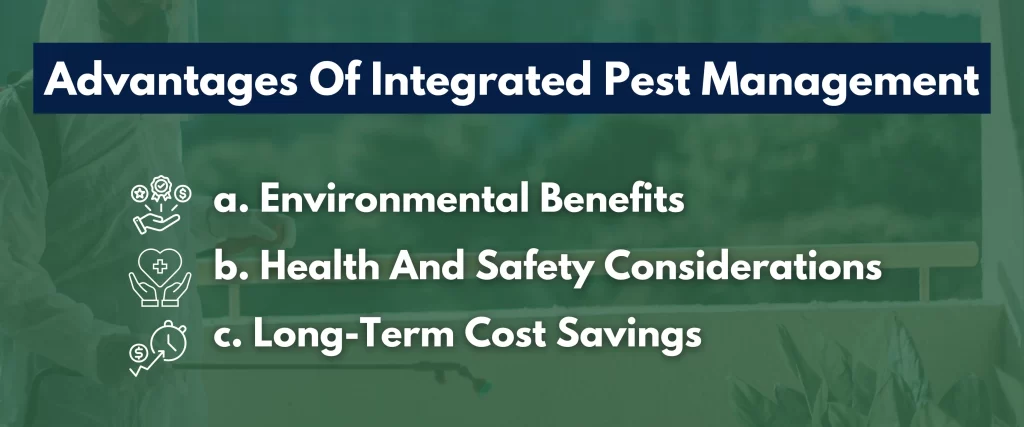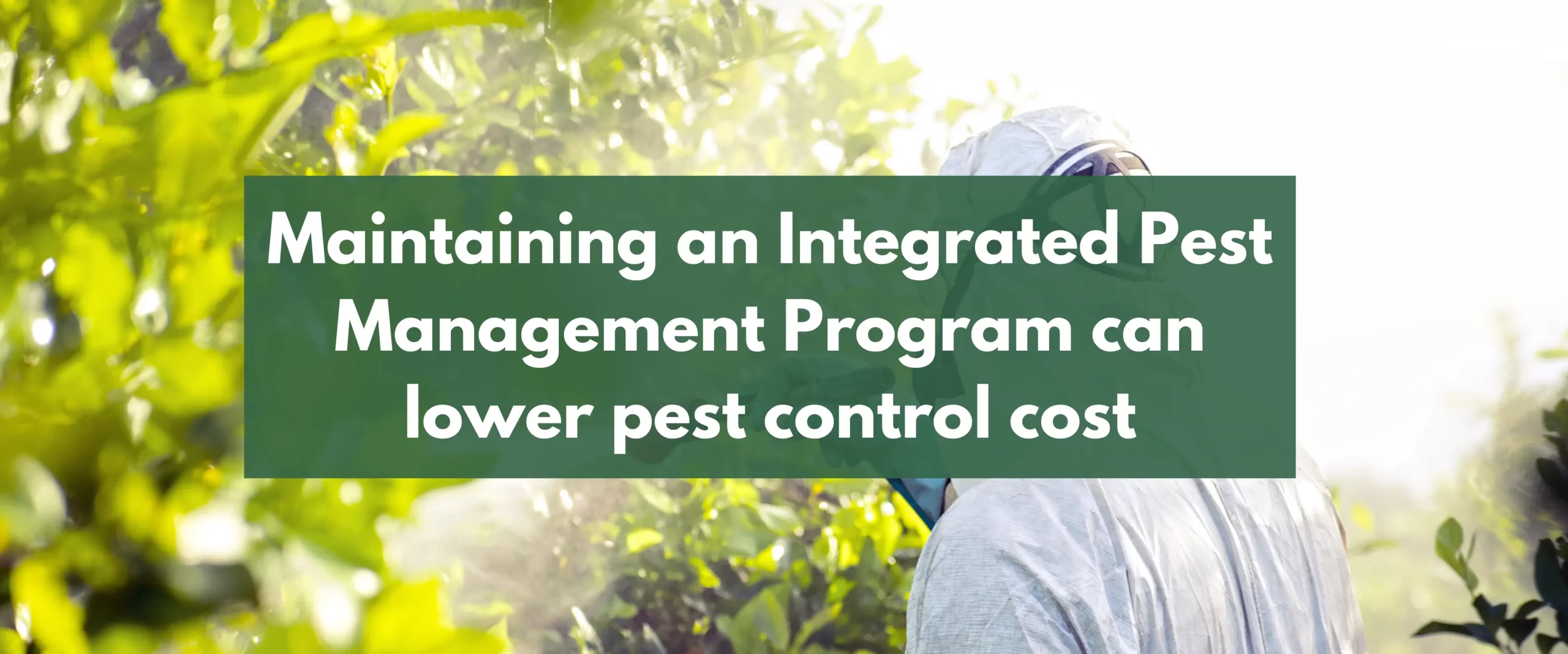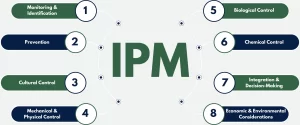Maintaining an Integrated Pest Management Program can lower pest control cost
Integrated Pest Management (IPM) stands as a beacon of sustainable pest control practices, emphasizing prevention, monitoring, and control techniques while minimizing harm to the environment and human health. In the United States, where property ownership is widespread, understanding and implementing effective IPM strategies are crucial for maintaining healthy living spaces. In this comprehensive guide, we delve into the nuances of IPM, its importance for property management, and how to implement it effectively.
Maintaining An Integrated Pest Management Program:
A. Key Principles of IPM
Maintaining An Integrated Pest Management (IPM) is a holistic approach to manage pests in agriculture and other settings while minimizing the impact on the environment and health. Here are the key principles:
Monitoring and Identification:
Regular monitoring of pest populations and their impact on crops or structures is essential. Accurate identification of pests and beneficial organisms helps in determining appropriate management strategies.
Prevention:
Preventing pest problems is preferable to controlling them. This involves implementing practices such as use of pest-resistant varieties, crop rotation, proper sanitation, and maintenance of a healthy environment.
Cultural Control:
Cultural practices like adjusting planting dates, spacing, and irrigation can help reduce pest populations or make crops less susceptible to damage.
Mechanical and Physical Control:
Physical methods such as trapping, barriers, and manual removal can be used to reduce pest without relying solely on chemical interventions.
Biological Control:
Utilizing natural exterminators, such as parasites, predators, and pathogens to control pest populations. This can involve introducing beneficial organisms or conserving existing populations through habitat management.
Chemical Control:
If necessary, pesticides are used as a last resort and are selected and applied in a manner that minimizes risks to health and the environment. This includes using selective pesticides, applying them at the right time and in the right manner, and rotating among different chemical classes to prevent resistance.
Integration and Decision-Making:
Combining multiple control tactics in a coordinated manner to achieve effective and sustainable pest management. Decisions are based on thorough knowledge of pest biology, ecology, and the local environment.
Economic and Environmental Considerations:
Evaluating the economic costs and benefits of different management options, including the long-term consequences for the environment and human health.
B. Benefits of Implementing IPM for Property Owners
Environmental Sustainability:
By reducing chemical pesticides and promoting natural pest control methods, IPM contributes to a healthier ecosystem.
Cost-Effectiveness:
Although initial setup costs may be higher, long-term savings are significant due to reduced pesticide use and fewer pest-related damages.
Reduced Reliance on Pesticides:
IPM reduces the need for frequent pesticide applications, thereby minimizing pesticide residues in the environment and potential health risks to humans and animals.
Components of an Integrated Pest Management Program
Pest Monitoring System:
Purpose:
The main goal of a pest monitoring system is to detect and assess pest populations accurately and in a timely manner.
Methods:
Monitoring methods vary depending on the pest and the environment but commonly include visual inspections, traps, pheromone traps, sticky traps, and using various monitoring tools like sweep nets in agricultural settings.
Frequency:
Monitoring should be conducted regularly throughout the growing season or as per the specific requirements of the environment to detect changes in pest populations and assess the effectiveness of control measures.
Benefits:
Early detection allows for timely intervention, preventing pest outbreaks and minimizing the need for extensive control measures.
Pest Exclusion:
Purpose:
Pest exclusion aims to prevent pests from entering the area or environment where they can cause damage.
Methods:
Physical barriers such as screens, nets, fences, and caulking are commonly used to exclude pests from buildings, greenhouses, and other structures. For agricultural settings, row covers and barriers can be employed to protect crops from pests.
Maintenance:
Regular maintenance and inspection of exclusion measures are crucial to ensure their effectiveness over time.
Benefits:
By preventing pests from entering the target area, the need for control measures inside the area is reduced, minimizing potential damage and the use of pesticides.
Biological Pest Control Methods:
Purpose:
Biological control involves using natural enemies of pests to control pest populations.
Methods:
This can include introducing predators, parasites, or pathogens that attack the pest directly or indirectly disrupt its life cycle. Conservation of existing natural enemies through habitat manipulation and planting of companion plants that attract beneficial insects are also part of biological control strategies.
Compatibility:
Biological control methods are compatible with other IPM components and can be integrated into pest management programs.
Benefits:
Biological control is often sustainable, reduces reliance on pesticides, and minimizes harm to non-target organisms and the environment.
Chemical Control as a Last Resort:
Purpose:
Chemical control involves the judicious use of pesticides as a last resort when other IPM methods are insufficient to manage pest populations effectively.
Criteria for Use:
Pesticides are selected based on factors such as their efficacy against the target pest, their impact on non-target organisms and the environment, and their compatibility with other control methods.
Application:
Pesticides are applied according to label instructions, taking into account factors such as timing, dosage, and application method to maximize effectiveness and minimize risks.
Monitoring and Evaluation:
The use of chemical control is monitored closely, and its effectiveness is evaluated to determine if alternative or additional control measures are necessary.
Risk Mitigation:
Measures are taken to minimize the risk of pesticide exposure to humans, animals, and the environment through proper handling, storage, and disposal.
Implementing Integrated Pest Management for Your Property

A. Assessing the Pest Situation on Your Property
- Begin by conducting a thorough inspection of your property to identify any existing pest problems. Look for signs of pest activity such as droppings, damage to structures or plants, nests, or tracks.
- Take note of any potential risk factors that may contribute to pest infestations, such as food sources, water sources, entry points, and shelter.
- Consider both indoor and outdoor areas of your property, as pests can inhabit various environments.
B. Developing a Customized IPM Plan
- Based on your assessment, design a tailored IPM plan that addresses the specific pest issues identified.
- Incorporate preventive measures into your plan to minimize the risk of future infestations. This may include sealing entry points, implementing proper sanitation practices, and removing sources of food and water.
- Outline strategies for monitoring and control, taking into account the type of pests present and the unique characteristics of your property.
- Utilize a combination of cultural, biological, physical, and chemical control methods as appropriate, prioritizing non-chemical options whenever possible to minimize environmental impact.
C. Partnering with a Professional Pest Control Service
- Seek assistance from licensed pest control professionals who specialize in IPM practices. These professionals have the expertise and resources to effectively implement and maintain your IPM program.
- Choose a reputable pest control service that emphasizes the use of IPM principles and demonstrates a commitment to sustainable pest management practices.
- Work closely with the pest control service to ensure that your customized IPM plan is properly executed and that any treatments applied are targeted and judiciously applied.
D. Regular Maintenance and Monitoring
- Consistently monitor your property for pest activity, using both visual inspections and monitoring tools such as traps or sensors.
- Address conducive conditions promptly to prevent pest problems from escalating. This may involve repairing leaks, improving ventilation, or eliminating clutter and debris.
- Regularly review and evaluate the effectiveness of your IPM plan, making adjustments as needed based on changes in pest activity or environmental conditions.
- Educate yourself and your staff or family members about IPM principles and the importance of proactive pest management practices to foster a culture of pest prevention and sustainability.
Advantages of Integrated Pest Management

A. Environmental Benefits
Promotes Biodiversity:
Unlike traditional pest control methods that often target specific pests with broad-spectrum pesticides, IPM focuses on ecosystem health. It encourages the presence of diverse plant and animal species, which in turn fosters a more balanced and resilient environment.
Reduces Pesticide Pollution:
Excessive use of pesticides can contaminate soil, water, and air, posing serious risks to environmental and human health. IPM employs a targeted approach, using pesticides only when necessary and in minimal amounts. This reduction in pesticide usage helps mitigate pollution and its adverse effects on ecosystems.
Protects Beneficial Insects, Birds, and Wildlife:
Many pesticides not only target pests but also harm beneficial insects, birds, and other wildlife. By employing methods such as biological control, habitat manipulation, and targeted pesticide application, IPM minimizes collateral damage to beneficial species, thereby preserving ecological balance.
B. Health and Safety Considerations
Minimizes Pesticide Exposure:
Pesticides, especially those used in conventional pest control, can pose significant health risks to humans and animals. IPM emphasizes non-chemical methods of pest control whenever possible, reducing the reliance on harmful pesticides. This approach lowers the risk of pesticide exposure for residents, pets, and wildlife, thus safeguarding their health.
Preserves Indoor Air Quality:
Indoor pesticide use can result in indoor air pollution, which can exacerbate respiratory issues and allergies. By adopting IPM strategies such as sealing entry points, improving sanitation, and using less toxic alternatives, indoor air quality can be preserved, promoting healthier living environments.
C. Long-term Cost Savings
Reduces Pesticide Use and Property Damage:
While the initial investment in implementing IPM practices may be higher compared to conventional pest control methods, the long-term cost savings are significant. By minimizing the need for frequent pesticide applications and preventing structural damage caused by pests, IPM reduces ongoing maintenance and repair expenses for property owners.
Prevents Pest Resistance:
Prolonged reliance on a single method of pest control, such as chemical pesticides, can lead to the development of resistant pest populations. IPM integrates multiple control tactics, making it more difficult for pests to adapt and develop resistance. This proactive approach prevents costly outbreaks of resistant pests in the long run.
Conclusion
Maintaining an Integrated Pest Management program offers a sustainable and effective approach to pest control for property owners in the USA. By understanding the principles of IPM and implementing customized strategies, property owners can achieve pest-free environments while minimizing environmental impact and safeguarding human health. Let’s embrace IPM as a proactive step towards sustainable pest control practices, ensuring a healthier future for generations to come.


